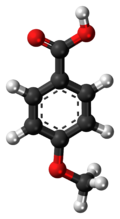| |||
| Names | |||
|---|---|---|---|
| Preferred IUPAC name 4-Methoxybenzoic acid | |||
| Other names Draconic acid | |||
| Identifiers | |||
3D model (JSmol) | |||
| 508910 | |||
| ChEBI | |||
| ChEMBL |
| ||
| ChemSpider | |||
| ECHA InfoCard | 100.002.562 | ||
| EC Number |
| ||
| 3499 | |||
| KEGG | |||
PubChem CID | |||
| UNII | |||
CompTox Dashboard (EPA) | |||
| |||
| |||
| Properties | |||
| C8H8O3 | |||
| Molar mass | 152.149 g·mol−1 | ||
| Density | 1.385 g/cm3 | ||
| Melting point | 184 °C (363 °F; 457 K) (sublimation) | ||
| Boiling point | 275 to 280 °C (527 to 536 °F; 548 to 553 K) | ||
| 1 part per 2500 | |||
| Acidity (pKa) | 4.47 [2] | ||
| Structure [3] | |||
| monoclinic | |||
| P21/a | |||
a = 16.98 Å, b = 10.95 Å, c = 3.98 Å α = 90°, β = 98.7°, γ = 90° | |||
Formula units (Z) | 4 | ||
| Hazards | |||
| GHS labelling: [4] | |||
 | |||
| Warning | |||
| H302, H315, H319, H335 | |||
| P261, P264, P270, P271, P280, P301+P312, P302+P352, P304+P340, P305+P351+P338, P312, P330, P332+P313, P337+P313, P362, P403+P233, P405 | |||
Except where otherwise noted, data are given for materials in their standard state (at 25 °C [77 °F], 100 kPa). | |||
p-Anisic acid, also known as 4-methoxybenzoic acid or draconic acid, is one of the isomers of anisic acid. The term "anisic acid" often refers to this form specifically. [1] It is a white crystalline solid which is insoluble in water, highly soluble in alcohols, and soluble in ether and ethyl acetate. [1]

